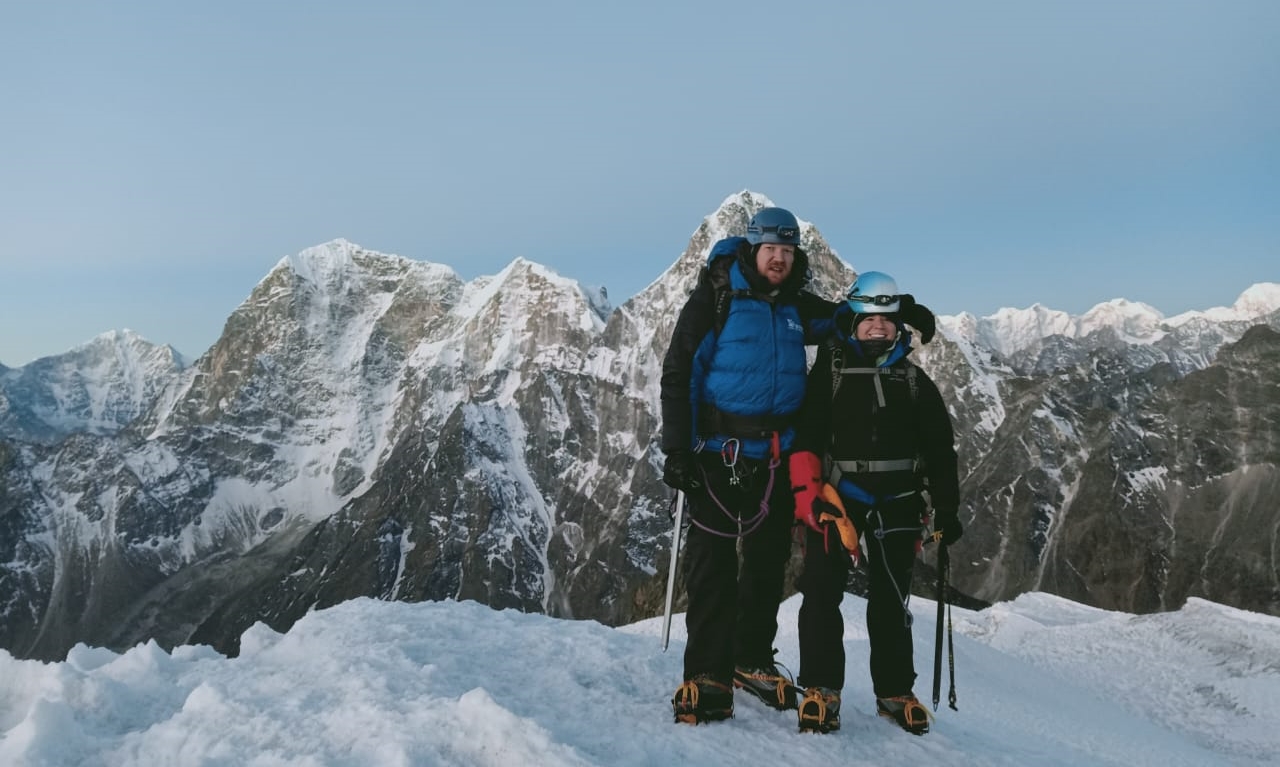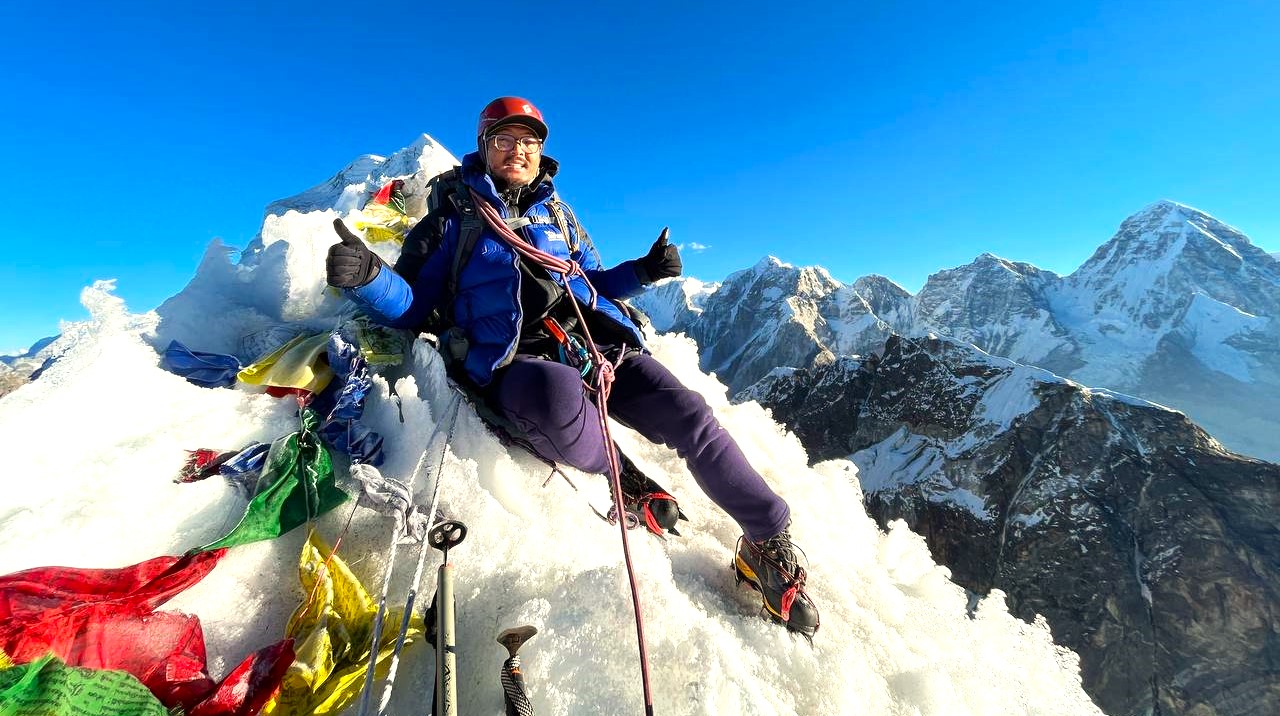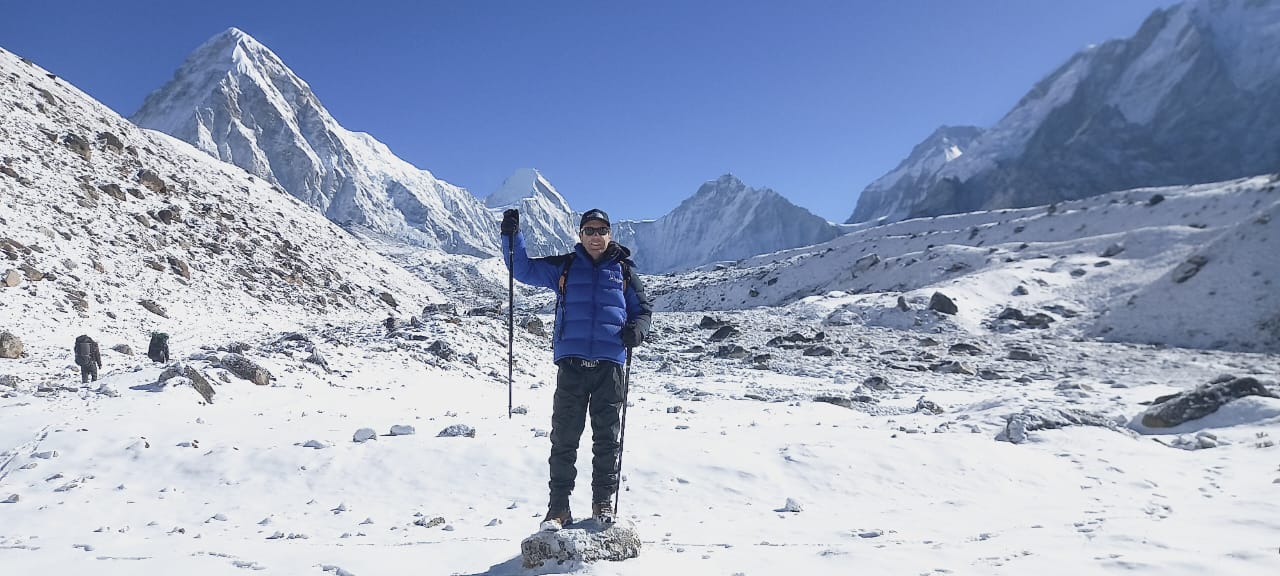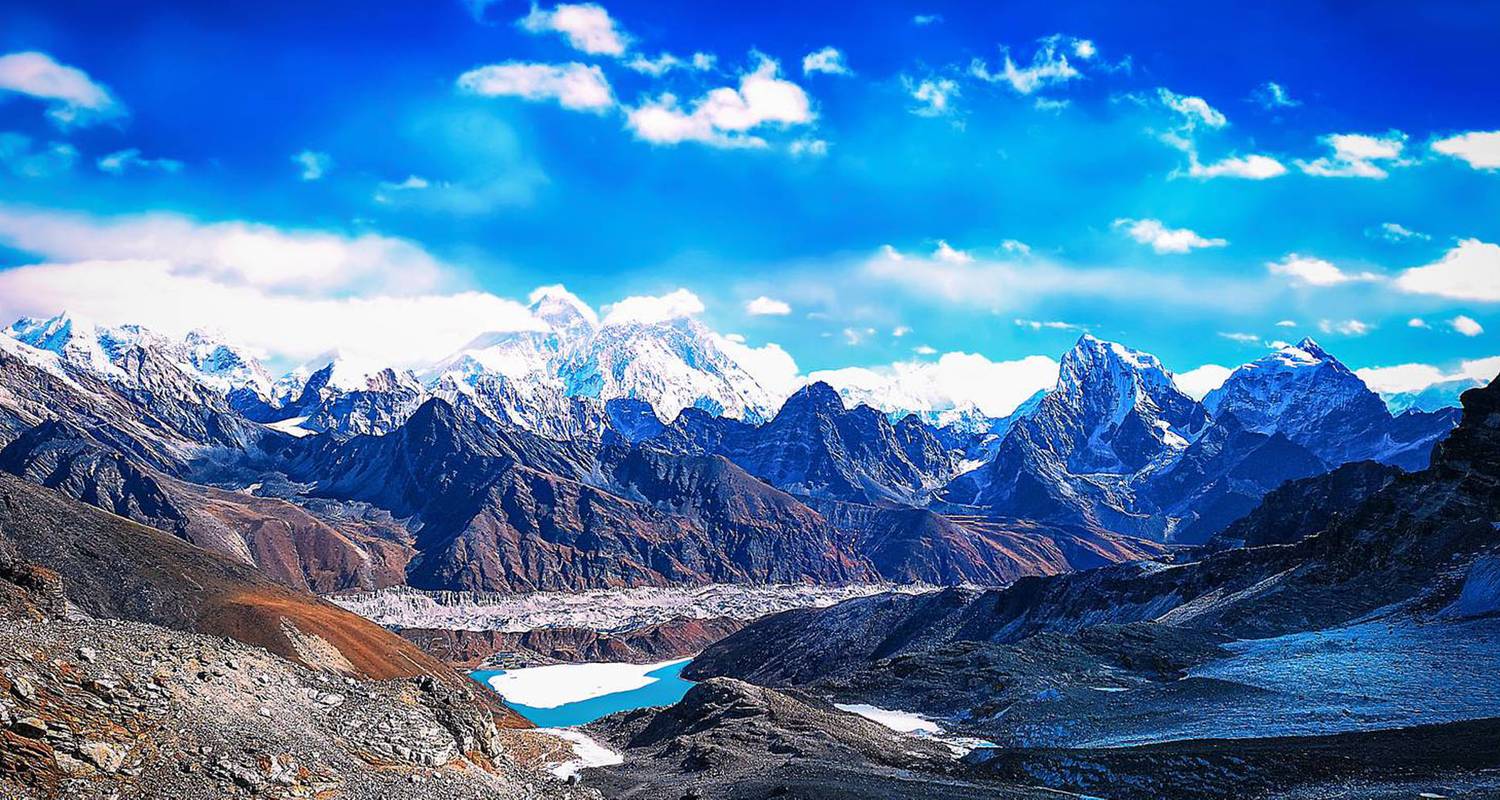26th August, 2025

May 25, 2024
Lobuche Peak Climbing In October
- Introduction
- History of Lobuche Peak
- Overview of Lobuche Peak Climbing
- Best Time to Climb Lobuche Peak in October
- How to Get to Lobuche Peak
- Required Permits for Lobuche Peak Climbing
- Equipment Needed for Lobuche Peak Climbing
- Physical Fitness and Training Required for Lobuche Peak Climbing
- Acclimatization and Altitude Sickness Prevention
- Daily Itinerary for Lobuche Peak Climbing in October
- Accommodation Options on Lobuche Peak Climbing Route
- Food and Water Availability on Lobuche Peak Climbing Route
- Safety Measures and Rescue Options on Lobuche Peak Climbing
- Tips for Successful Summit of Lobuche Peak
- Environmental Considerations While Climbing Lobuche Peak
- Cultural Aspects of Lobuche Peak Climbing
- Challenges Faced During Lobuche Peak Climbing
- Personal Experiences of Climbers on Lobuche Peak
- Costs Involved in Lobuche Peak Climbing
- Other Popular Peaks to Climb in the Vicinity of Lobuche Peak
- Conclusion
- Lobuche Peak Climbing Packages
October offers an ideal window for climbers seeking to conquer Lobuche Peak, a majestic summit nestled in the Khumbu region of Nepal. Rising to an elevation of 6,119 meters (20,075 feet), Lobuche Peak presents a challenging yet rewarding endeavor for mountaineers, blending technical climbing with awe-inspiring Himalayan scenery.
As October marks the end of the monsoon season in Nepal, climbers can expect stable weather conditions with clear skies and crisp mountain air, facilitating a safer ascent. The trek to Lobuche Base Camp itself is a breathtaking journey through picturesque Sherpa villages, dense rhododendron forests, and alongside glacier-fed rivers. October enhances this trekking experience with lush vegetation and blooming flowers, painting the landscape in vibrant hues of green and red.
The climb to Lobuche Peak is carefully planned, typically requiring acclimatization stops in Namche Bazaar and Dingboche to adapt to the high altitude. As climbers progress towards Lobuche Base Camp, situated at approximately 4,940 meters (16,207 feet), the terrain becomes more rugged, offering panoramic views of neighboring peaks such as Ama Dablam and Tawache.
From Base Camp, climbers ascend through rocky trails and glacier moraines, navigating crevasses and ice formations under the guidance of experienced Sherpa guides. The route includes technical sections that demand proficiency in ice climbing and the use of climbing equipment like crampons and ropes. However, the challenge is rewarded with unparalleled vistas of Everest (8,848 meters/29,029 feet), Lhotse (8,516 meters/27,940 feet), and Nuptse (7,861 meters/25,791 feet) from Lobuche Peak’s summit.

LOBUCHE PEAK CLIMBING
Lobuche East (6,119m/20,075ft), set in Nepal's stunning Khumbu on the Nepalese side of Everest.The best time to go trekking in Nepal is in Autumn (September-November) and in...
October’s favorable weather conditions not only provide clear visibility for climbers but also enhance the overall experience with comfortable daytime temperatures and cooler nights. Evenings at Base Camp are spent sharing stories with fellow climbers, savoring hearty Sherpa meals, and gazing at the star-studded Himalayan skies.
Lobuche Peak climbing in October is an adventure that blends physical challenge with natural beauty, cultural immersion, and the camaraderie of like-minded adventurers. It offers a chance to test one’s mountaineering skills in a pristine Himalayan setting while forging memories that will last a lifetime. Whether you’re a seasoned climber seeking new heights or embarking on your first Himalayan expedition, October promises an unforgettable journey to the roof of the world.
Introduction
Lobuche Peak stands as a formidable yet alluring peak in the Khumbu region of Nepal, offering climbers a challenging ascent amidst breathtaking Himalayan vistas. Situated near Everest Base Camp, Lobuche Peak beckons adventurers with its striking beauty and technical climbing opportunities. This introduction sets the stage for exploring its history, climbing overview, ideal timing in October, and logistical considerations.
History of Lobuche Peak
Lobuche Peak, comprising two main summits, East (6,119m) and West (6,145m), was first climbed in 1984 by a Polish expedition via the East Ridge. Its name derives from the nearby village of Lobuche, nestled along the popular Everest Base Camp trekking route. Over the years, Lobuche Peak has become a coveted destination for mountaineers seeking to challenge themselves amidst the world's highest peaks, blending technical skill with awe-inspiring natural beauty.
Overview of Lobuche Peak Climbing
Climbing Lobuche Peak involves a carefully planned expedition that typically begins with a trek from Lukla through the Khumbu Valley, passing through vibrant Sherpa villages and stunning alpine landscapes. The climb itself is renowned for its technical challenges, including steep ice and rock faces that require climbers to be proficient in ice climbing and the use of climbing gear such as crampons and ropes. The journey culminates in breathtaking panoramic views from the summit, including iconic Himalayan peaks like Everest, Lhotse, and Nuptse.
Best Time to Climb Lobuche Peak in October
October emerges as one of the best times to climb Lobuche Peak due to stable weather conditions following the monsoon season. The month offers clear skies, mild daytime temperatures ideal for climbing, and reduced precipitation, ensuring safer and more enjoyable climbing conditions. The landscape is adorned with lush vegetation and blooming rhododendrons, enhancing the trekking experience to Lobuche Base Camp. October also allows climbers to witness stunning autumnal hues and enjoy clear views of the surrounding Himalayan giants.
How to Get to Lobuche Peak
To reach Lobuche Peak, climbers typically fly from Kathmandu to Lukla, the gateway to the Everest region. From Lukla, a trekking route leads through Namche Bazaar, Tengboche, Dingboche, and ultimately to Lobuche Base Camp. The journey involves acclimatization stops to adjust to the altitude and usually takes around 10-12 days round-trip from Lukla, depending on the itinerary and climber's pace. Local guides and porters play a crucial role in supporting climbers, providing navigation expertise and logistical support throughout the expedition.

LOBUCHE PEAK SUMMIT RETURN BY HELICOPTER
A real climbing adventure that will leave you stunned at the beauty of the Himalayan Mountains. The Lobuche Peak Climbing expedition in the spectacular Khumbu region of Nepal has been ranked by Lonely...
Required Permits for Lobuche Peak Climbing
Climbing Lobuche Peak requires obtaining several permits and permissions. Firstly, climbers need a permit from the Nepal Mountaineering Association (NMA) to climb any peak in Nepal, including Lobuche Peak. Additionally, a Sagarmatha National Park entry permit is mandatory as Lobuche Peak lies within its boundaries. The permits can be obtained through registered trekking agencies, and climbers must provide necessary documentation such as passport copies and passport-sized photographs. It's essential to arrange these permits well in advance to ensure a smooth start to the expedition.
Equipment Needed for Lobuche Peak Climbing
Climbing Lobuche Peak demands a comprehensive set of equipment to ensure safety and success. Essential gear includes mountaineering boots, crampons, ice axe, harness, helmet, ropes, and a variety of protective clothing such as down jackets, insulated pants, and gloves suitable for extreme cold. Climbers should also carry a sleeping bag rated for sub-zero temperatures and a high-altitude tent. Other necessary items include a headlamp with spare batteries, a first aid kit, sunglasses, sunscreen, and a water purification system. The technical nature of the climb necessitates careful packing and preparation, ensuring climbers are equipped to handle the challenges of high-altitude mountaineering.
Physical Fitness and Training Required for Lobuche Peak Climbing
Preparing for Lobuche Peak climbing requires a high level of physical fitness and specific training. Climbers should focus on cardiovascular endurance, strength training for the lower body (especially legs and core), and exercises that improve overall stamina and flexibility. Endurance activities such as hiking, running, and cycling are beneficial for building cardiovascular fitness, essential for sustained exertion at high altitudes. Strength training should include exercises targeting muscles used in climbing, such as squats, lunges, and abdominal workouts.
Additionally, climbers should engage in altitude acclimatization exercises and practice using climbing equipment such as ropes and harnesses. Training hikes in mountainous terrain with a weighted backpack simulate the physical demands of the ascent and aid in acclimatization. Adequate preparation not only enhances physical performance but also prepares climbers mentally for the challenges of the climb, ensuring a safer and more enjoyable experience on Lobuche Peak.
Acclimatization and Altitude Sickness Prevention
Acclimatization is crucial for climbers attempting Lobuche Peak to mitigate altitude sickness and ensure a safer ascent. The ascent should be gradual, allowing the body time to adjust to reduced oxygen levels at higher altitudes. Typical acclimatization stops include Namche Bazaar (3,440m/11,286ft), Dingboche (4,410m/14,468ft), and Lobuche Base Camp (4,940m/16,207ft). It's essential to stay hydrated, avoid alcohol and tobacco, and ascend slowly, allowing for rest days to aid in acclimatization. Climbers should monitor their health closely and be prepared to descend if symptoms of altitude sickness, such as headaches, nausea, or dizziness, persist.

LOBUCHE PEAK EXPEDITION 15 DAYS
Lobuche Peak Expedition is a thrilling adventure that takes you to the heart of the Khumbu region in Nepal. The peak stands at an altitude of 6,119 meters and offers stunning views of the surrounding...
Daily Itinerary for Lobuche Peak Climbing in October
A typical itinerary for climbing Lobuche Peak in October spans around 14-16 days, factoring in acclimatization and weather conditions. Starting from Lukla, the trek proceeds through Namche Bazaar, Tengboche, Dingboche, and finally to Lobuche Base Camp. Climbers spend several days at Base Camp for acclimatization and training before making summit attempts. Summit day usually begins early to take advantage of stable weather conditions, with climbers returning to Base Camp the same day or descending to lower altitudes depending on their physical condition and itinerary.
Accommodation Options on Lobuche Peak Climbing Route
Accommodation along the Lobuche Peak climbing route varies from basic tea houses to tented camps. Tea houses offer dormitory-style rooms with shared facilities and provide meals ranging from local Sherpa cuisine to international dishes. As climbers ascend, accommodations become more basic, with fewer amenities but still providing essential comforts like warm bedding and hot meals. At Lobuche Base Camp, climbers typically stay in expedition-style tents equipped with sleeping bags and insulated mats. It's essential to book accommodations in advance, especially during peak climbing seasons, to ensure availability and proper rest during the ascent.
Food and Water Availability on Lobuche Peak Climbing Route
Food and water availability on the Lobuche Peak climbing route are primarily provided by tea houses and expedition camps. Meals at tea houses include a variety of options such as soups, noodles, rice dishes, and seasonal vegetables, catering to both Western and Nepali tastes. Tea houses also serve hot beverages like tea and coffee, which are essential for staying hydrated and maintaining warmth. As climbers ascend higher, food options may become more limited, focusing on high-energy foods suitable for mountain conditions. Water is typically boiled or treated with purification tablets to ensure safety, and climbers are encouraged to carry sufficient hydration systems or water bottles to stay hydrated throughout the journey.
Safety Measures and Rescue Options on Lobuche Peak Climbing
Safety on Lobuche Peak climbing expeditions is paramount, given the technical nature and high-altitude challenges involved. Climbers should prioritize comprehensive travel insurance that covers mountaineering and emergency evacuation services. It's crucial to climb with experienced guides who are well-versed in high-altitude rescue techniques and equipped with satellite phones or radios to maintain communication in remote areas. Climbers must adhere to weather forecasts and monitor conditions closely to avoid hazardous situations such as avalanches or severe storms. Personal safety equipment, including helmets and avalanche gear, should be carried and used as necessary. In case of emergencies, helicopters can be summoned for evacuations from higher camps to medical facilities in Kathmandu or nearby towns. Preparing and adhering to a detailed itinerary with contingency plans ensures prompt responses to any unforeseen circumstances, safeguarding the well-being of climbers throughout the expedition.

LOBUCHE PEAK EXPEDITION 14 DAYS
The Lobuche Peak Expedition is a 14-day trekking adventure that takes you to the heart of the Khumbu region in Nepal. It is a popular trekking peak in the Himalayas, with stunning views of the surroun...
Tips for Successful Summit of Lobuche Peak
Achieving a successful summit of Lobuche Peak requires meticulous planning, physical preparation, and mental fortitude. Begin training well in advance to build endurance, strength, and acclimatization. Familiarize yourself with the technical climbing skills required, such as ice climbing and rope management. Choose a reputable guide service with a proven track record of successful climbs. Optimize your gear selection for comfort and safety, ensuring it includes high-altitude essentials like crampons, a helmet, and a down suit. Monitor weather conditions closely and plan summit attempts during stable weather windows. Maintain a positive mental attitude and listen to your body, recognizing signs of altitude sickness and adjusting your pace accordingly. Finally, cherish the journey and celebrate each milestone, whether it's reaching Base Camp or standing atop the summit, while respecting the mountain and its challenges.
Environmental Considerations While Climbing Lobuche Peak
Climbing Lobuche Peak necessitates a deep respect for the fragile Himalayan environment. Minimize waste by carrying out all non-biodegradable items, including batteries and packaging, to disposal facilities in Kathmandu. Use reusable water bottles and purification methods to reduce plastic waste. Stay on established trails and minimize erosion by avoiding shortcuts or trampling vegetation. Respect local wildlife and refrain from disturbing natural habitats. Burn only dry wood for cooking and heating to preserve local resources and minimize air pollution. Consider supporting eco-friendly lodges and tour operators that prioritize sustainable practices. By adopting Leave No Trace principles and respecting local customs, climbers can contribute to the preservation of the pristine mountain environment for future generations.
Cultural Aspects of Lobuche Peak Climbing
Climbing Lobuche Peak offers a unique opportunity to immerse oneself in the rich cultural heritage of the Sherpa people and the Everest region. Interactions with local communities along the trekking route provide insights into Sherpa traditions, hospitality, and daily life. Visit monasteries such as Tengboche Monastery, a spiritual center for Sherpas and Tibetan Buddhists, to experience ancient rituals and ceremonies. Respect local customs and traditions, such as prayer flag etiquette and Buddhist shrines, by asking permission before photographing or participating in religious activities. Support local economies by purchasing handmade crafts and goods from Sherpa artisans. Participate in cultural exchanges by learning basic Nepali phrases and sharing stories with fellow trekkers and locals. By embracing cultural sensitivity and awareness, climbers enrich their climbing experience while forging meaningful connections with the people of the Everest region.
Challenges Faced During Lobuche Peak Climbing
Climbing Lobuche Peak presents several challenges that test the endurance, technical skill, and mental fortitude of mountaineers. The ascent involves navigating steep ice and rock faces, requiring proficiency in ice climbing and the use of technical gear like crampons and ropes. High-altitude conditions pose risks of altitude sickness, demanding careful acclimatization and awareness of symptoms. Weather fluctuations in the Himalayas can lead to sudden storms or avalanches, necessitating flexibility in summit attempts and safety precautions. Physical fatigue and mental resilience are critical as climbers endure long days of strenuous trekking and summit pushes. Logistics such as obtaining permits, arranging accommodations, and coordinating with guides add logistical complexities. Despite these challenges, climbers are rewarded with breathtaking views from the summit and a profound sense of accomplishment upon conquering Lobuche Peak.

ISLAND AND LOBUCHE PEAK CLIMBING
Lobuche and Island Peak combo climbing expedition is a thrilling adventure that offers a unique opportunity to conquer two popular peaks in the Everest region of Nepal. Lobuche Peak (6,119m) and Islan...
Personal Experiences of Climbers on Lobuche Peak
Climbers recount diverse experiences on Lobuche Peak, each shaped by personal goals, challenges faced, and the unique beauty of the Himalayan landscape. Many describe the initial trek through Sherpa villages and dense forests as immersive cultural experiences, forging bonds with local guides and fellow climbers. Acclimatization stops in Namche Bazaar and Dingboche provide opportunities to adapt to altitude and soak in stunning mountain vistas. The climb to Lobuche Base Camp is often highlighted by encounters with yak caravans and breathtaking views of Everest and surrounding peaks. Summit attempts are characterized by early morning starts, exhilarating technical climbs, and moments of reflection at the summit. Climbers share stories of camaraderie, resilience in overcoming physical and mental hurdles, and the euphoria of standing atop Lobuche Peak, capturing memories that endure long after the descent.
Costs Involved in Lobuche Peak Climbing
The cost of climbing Lobuche Peak varies based on factors such as the climbing season, guide services, and logistical arrangements. Permit fees, including Nepal Mountaineering Association (NMA) and Sagarmatha National Park entry permits, constitute a significant portion of expenses. Costs for experienced guides, porters, and trekking agencies depend on services provided, including accommodations, meals, and equipment rental. Additional expenses may include travel insurance, gear purchase or rental, visa fees, and tips for guides and support staff. Budgeting for contingency expenses, such as unforeseen weather delays or emergency evacuations, is advisable. Climbers can choose from budget to luxury accommodations along the trekking route, with prices reflecting amenities and services offered. Overall, careful planning and consideration of individual preferences and comfort levels ensure a rewarding and memorable Lobuche Peak climbing experience.

ISLAND PEAK CLIMBING
Sherpa Expedition & Trekking (Est.1977) are pleased to announce FOR ADVENTURERS the most awesome, exhilarating & unforgettable climbing and treks on offer anywhere today!...
Other Popular Peaks to Climb in the Vicinity of Lobuche Peak
Lobuche Peak is surrounded by several iconic peaks that attract climbers seeking diverse mountaineering challenges in the Everest region. Nearby peaks include Island Peak (6,189m/20,305ft), known for its stunning views and technically demanding climb that includes a steep ice wall. Ama Dablam (6,812m/22,349ft) is celebrated for its elegant pyramid shape and requires climbers to navigate rock, ice, and exposed ridges. Mera Peak (6,476m/21,247ft) offers a less technical ascent suitable for novice climbers, featuring panoramic views of Everest, Makalu, and Cho Oyu. Each of these peaks provides a unique mountaineering experience, blending technical climbing with Himalayan scenery and cultural immersion. Climbers can tailor their expeditions to include multiple peaks, creating a comprehensive exploration of the Khumbu region's natural beauty and mountaineering challenges.
Conclusion
Climbing Lobuche Peak is a transformative journey that combines physical challenge with cultural immersion and natural beauty in the heart of the Himalayas. From the initial trek through Sherpa villages to the technical ascent to the summit, climbers encounter diverse landscapes, forge lasting connections with local communities, and test their skills amidst some of the world's highest peaks. Challenges such as altitude acclimatization, weather variability, and logistical planning enrich the experience, fostering resilience and personal growth. The costs involved reflect the investment in safety, expertise, and the opportunity to achieve a lifelong dream of summiting a Himalayan peak. Whether embarking on Lobuche Peak as a solo climber or part of a guided expedition, the journey leaves an indelible mark, inspiring reverence for the mountains and a deep appreciation for the spirit of adventure.
Lobuche Peak Climbing Packages
Lobuche Peak Summit Return By Helicopter
Lobuche Peak Expedition 14 Days
Lobuche Peak Expedition 15 Days

Everest Three High Pass Trek with Island Peak Climbing
The Everest Three High Pass Trek with Island Peak Climbing is an exhilarating and challenging adventure that takes you through the stunning landscapes of the Everest region in Nepal. This 23-25...
Any Questions? Let Us Know.
Recent Posts
17th June, 2025


















